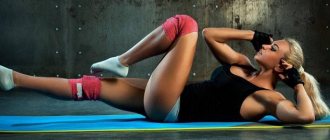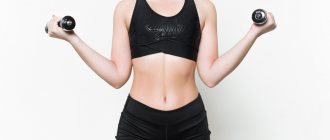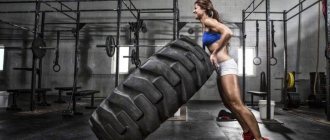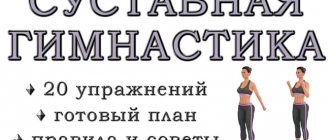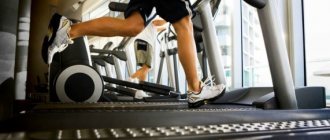The history of stretching does not have a precisely defined date that could be called the origin of this area of physical activity. According to some sources, movements similar to elements of modern stretching were performed in ancient Rome, they were used by gladiators before entering the arena. On the other hand, in search of the origins of modern stretching, you can go even deeper into the depths of history, comparing it with yoga, which is no less than four thousand years old.
However, if we consider a period of time closer to the present, then Sweden can be considered the ancestor of the modern stretching system, where this movement, as a separate type of training, began to emerge in the 50s of the last century.
Today we will talk about stretching. We will discuss the nuances of all options for performing exercises, and also provide several practical descriptions for each of them and discuss the effect of stretching on the body.
Benefits of stretching for women
Everyone needs stretching, regardless of athletic training, purpose of exercise, age or gender. Flexibility exercises are important to begin and end any strength or cardio workout. But women should pay special attention to stretching. And there are good reasons for this!
Resistant to injury
Tough muscles are easy to damage. And given that after 30 years, muscle fibers become less and less elastic, the risk of injury increases every year. And it's not just about working in the gym. Every awkward movement on ice, sledding with a child or trying to cope with roller skates can result in a ruptured or sprained ligament. For girls who have included stretching in their training program, all these situations are not at all scary: their muscles are relaxed and their ligaments are elastic.
The right and left sides of the body have different flexibility for all people. And the range of movements is wider when a person is in a good mood.
Effective training
The higher the flexibility, the wider the range of motion. The wider the amplitude, the more effective each approach is. If you don't ignore stretching, your strength will only increase from workout to workout. And since stretching improves the flow of blood and oxygen to the muscles, they will be better supplied with nutrients. The girl will feel the effect as the absence of soreness even after very active activities and the rapid recovery of the body.
Excellent posture
The main benefit of stretching is relaxation and simultaneous strengthening of muscles. The feeling of tightness goes away, the gait becomes easier, movements are smoother, and keeping your back straight is no longer difficult. Need I say that with this comes self-confidence and the birth of love for one’s own body?!
Often the cause of an uneven, stiff gait is low elasticity of individual joints.
Flawless menstrual cycle
Have you ever wondered how female athletes manage to train during menstruation?! It's simple: according to statistics, only 5% of women who regularly go to the gym suffer from PMS symptoms and experience pain during menstruation. For the remaining 95%, their health does not deteriorate at all during these few days. Stretching in this regard is one of the most useful workouts for the female body. Stretching improves blood circulation, normalizes the cycle and effectively prevents uterine spasms. With the start of regular exercise, the pelvic muscles become more elastic, and nagging pain gradually goes away.
A slim body
Typical problem areas for women are the lower abdomen and thighs. But if you strive for the splits every day for at least a few minutes, after six months you will notice that cellulite has disappeared, the inner thigh has tightened, and the waist has become much thinner. There is no magic in this: thanks to stretching, blood supply to the pelvic organs improves, intestinal function normalizes and skin elasticity increases. All metabolic processes accelerate, and active fat burning begins. And you can already be proud of the reflection in the mirror.
Sometimes the cause of crooked legs is poorly developed ligaments. Doing the splits strengthens the adductor muscles, making your legs stronger and more beautiful. Moreover, the effect of stretching is visually much more noticeable than the result of strength training.
Healthy joints
A sedentary lifestyle, previous injuries, age - all this worsens the condition of the musculoskeletal system. Some people begin to notice stiffness in the lower back after waking up, while others suffer from daily tension headaches. Some women complain that their knees ache before every change in the weather, others complain that they cannot bend over without experiencing discomfort. Experienced trainers know: all these symptoms are typical for people with low flexibility. Their cause: insufficient elasticity of the quadriceps, back muscles or ligaments of the iliopsoas. In such situations, any ointments, tablets and even massages bring only temporary relief. But stretching can solve the problem by eliminating not the symptom, but the cause.
Interestingly, back pain can plague even girls who spend a lot of time in the gym, but do not pay due attention to stretching exercises.
In this case, it is impossible to perform most strength exercises: squats, lunges correctly. The technique is distorted, and at best, training will not strengthen the muscle frame. At worst, they will provoke even more damage to the ligaments. Therefore, if after training you feel tension in your lower back, know: only stretching will help.
Resistance to stress
Everyday experiences undermine women’s health no worse than physical inactivity and poor nutrition. And now I have absolutely no strength for full-fledged workouts in the gym. But don’t rush to lie down on the sofa if you’re chronically tired; it’s better to sign up for a stretching class. A leisurely rhythm, calm music, smooth leisurely movements will relax you after a working day, relieve muscle tension and simply bring pleasure. If you exercise regularly, seasonal depression will not be scary. And very soon you will have the strength for more active training.
Psychologists can identify internal problems by body movements. But the pattern also works in the opposite direction: once you remove the muscle tension, psychological barriers gradually disappear.
Vivid sexual impressions
Fitness club regulars will whisper to you about these benefits of stretching after their first stretching workout. In fact, any physical activity increases libido. But exercises to develop flexibility especially actively stimulate the pelvic muscles, relieve tension and generally increase your own self-esteem. All this is reflected in behavior in bed and guarantees bright, passionate nights.
The benefits of stretching for older women
You can often hear that after 40 years there is no point in doing stretching, they say, you won’t be able to do the splits anyway.
- First of all
, this is not true! Flexibility is a very individual indicator, and sometimes people who were completely unathletic in their youth achieve impressive results in adulthood. And, on the contrary, there are young girls who are absolutely “wooden” by nature. - Secondly
, muscle stretching is a natural self-regulation mechanism conceived by nature (remember with what pleasure we stretch in the morning). In this way, our body regulates the activity of systems and organs.
With each passing year, the muscles become more rigid and the connective tissue loses its elasticity. This is why high-impact activities like aerobics or running can lead to injuries in mature women. But stretching, on the contrary, will pause the biological clock.
Stretching always hurts, so you have to be patient
Perhaps it’s time to hang a sign in every studio: “Do not tolerate pain!” Pain is a danger signal sent by the nervous system. Enduring pain is a direct path to injury. There is a pain scale from 0 to 10, where 0 means I don’t feel anything, and 10 means unbearable pain. So, in classes you should always be between 5-6 points. It can be a pleasant, sometimes nagging sensation, but not a sharp and burning pain. You should learn to listen to the body and recognize signals.
Photo: istockphoto.com
Can pregnant women do stretching?
Stretching is one of the few types of fitness that can be done at any stage of pregnancy, right up to childbirth. Regular exercise makes the skin more elastic and greatly reduces the likelihood of stretch marks.
By activating all major muscle groups, the set of exercises reduces the load on the spine and relieves the expectant mother of lower back pain. The ability to feel your body will also help during childbirth: as a rule, women who regularly find time to visit a fitness club give birth easily and painlessly.
Twisting and bending back, lying on the stomach and any exercises that involve the abdominal muscles are contraindicated during pregnancy. If during exercise you experience nausea, dizziness, or heaviness in the lower abdomen, you should stop training immediately.
Stretch complex for the whole body
Let's give an example of a simple set of stretching exercises, with which you can work the main muscle groups of the whole body.
Stretch your upper body:
- Take a standing position with your feet apart.
- Bend your knees slightly.
- Bend your head forward and grab the back of your head with your hands.
- As you exhale, gently press your chin to your chest, pointing your elbows towards each other.
- At the end of the exhalation, hold the position for 10-15 seconds and resume even, deep breathing.
- Without changing the starting position, put your hands behind your back and lock them together.
- Fill your chest as much as possible with a deep breath and move your arms as far back and up as possible.
- Return to the starting position and clasp your head with one of your hands on the side of the opposite ear.
- As you exhale, gently move your head toward the shoulder of your working side.
- Switch sides.
- Return to the starting position and bend your knees a little more.
- Bend slightly forward and clasp your hands under your knees.
- As you exhale, smoothly lift your body up, without releasing the grip under your knees.
- Return to the starting position, and with one of your hands grab your opposite elbow, pressing it to your chest.
- Switch sides.
With this complex we have stretched the upper body well, now we can move on to the lower part:
- Take a standing position with your feet apart.
- With one of your hands behind your back, grab the toe of your foot on the same side and press your heel to your buttock.
- Switch sides.
- From the starting position, place one of your legs forward with your toes facing you.
- As you exhale, gently bend toward your extended leg and grab your toes.
- Hold the position for 10-15 seconds, then return to the starting position and switch sides.
Let's move on to the final complex:
- Assume a plank position with your arms straight.
- Leaning on your toes, place your feet as close to each other as possible.
- Place one of your feet with your toe on the opposite heel and smoothly move your body back, stretching your calf muscle.
- Switch sides.
- From the plank position, move into a forward lunge position on one of your legs.
- As you exhale, smoothly tilt your body forward along the medial side of your front leg, and fix the position on your elbows.
- The elbow can be placed behind the foot and fixed on the floor on the lateral side of the ankle.
- Hold the position for 10-15 seconds and change sides.
Conclusion
To do quality stretching, you don’t have to be in excellent physical shape or have any special skills. Everyone can learn to stretch competently, regardless of their initial level of flexibility and sports experience. You can stretch at any time and place convenient for you. In addition to relaxation and the ability to restore muscle tone, regular stretching brings a lot of benefits: it develops coordination, increases the working range of movements, has a beneficial effect on the nervous and immune systems, and also increases longevity in sports. Stretching for at least 15 minutes a day and enjoy excellent health, training productivity and constant progress.
Articles on our website are presented for educational and informational purposes only. We do not recommend using article materials as medical advice. If you decide to take dietary supplements or make fundamental changes to your diet, first consult with a specialist.
Proofreader and editor: Farida Seidova
Types of stretching
All stretching exercises can be divided into three main categories:
- Static stretching
. Having taken a certain position, a person freezes for several seconds, and sometimes minutes, concentrating on the muscles involved. - Dynamic stretching
. These are soft springy movements, the amplitude of which becomes wider with each approach. - Ballistic stretch
. Wide swinging movements with legs or arms that are repeated many times. Typically, it is these exercises that make up the warm-up plan.
Statistical stretching makes joints and ligaments more elastic and develops overall flexibility. Dynamic and ballistic varieties are aimed at improving agility, increasing muscle strength and strength.
Stretching training programs
On our website you can try real and effective stretching classes.
Stretching course – an e-book with the necessary theory and ready-made sets of exercises.
Effective stretching – 30-day training taking place online in a closed group. Currently, the training has three levels of difficulty. The plans are to develop a six-step program with gradual complication.
Harm and contraindications of stretching
For all its benefits, stretching puts a serious strain on the back and joints. Therefore, in some cases it is better to avoid stretching:
Contraindications:
- Recovery period after fractures.
- Dislocation of joints.
- Spinal hernias.
- Thrombophlebitis and varicose veins.
- Arthrosis and arthritis during exacerbation.
The greatest harm during stretching comes from the desire to achieve the goal as quickly as possible. Stretching through tears inevitably leads to injury, as does improper exercise technique. If you want to do the splits, stop doing amateur activities! Stretching, especially at first, should be done under the guidance of an experienced instructor.
If you don’t constantly stretch, the splits will disappear.
If you practice with working amplitudes, constantly train the nervous system by working with muscles, and use the overload method, then you will be able to do the splits even after a month of break. The body will get used to it and remember everything you taught it. But you need to use all types of stretching (except passive!) and use what you have taught your body. Otherwise, rollbacks will occur without interruption.
Stretching is a great way to relieve fatigue at the end of the working day, tone your muscles, and improve elasticity and mobility throughout the body. However, just stretching is not enough; integrate exercises for control, coordination and strengthening of the muscle corset for maximum results.
Tips for Beginners
To experience the full benefits of stretching, instructors advise spending 30 minutes stretching 2-4 times a week. This can be either an independent activity or part of a training program. In the latter case, ballistic and dynamic stretching begins strength or cardio training, and lasts no more than 5-7 minutes. The correct way to end the session is with static stretching. There is no need to rush:
- breathe evenly and calmly;
- do not make any sudden movements;
- know how to feel the line beyond which pleasant tension turns into burning pain.
Shoes for stretching training may not be needed at all: in some gyms girls work out in socks, but in most cases they can do without them. But clothes for stretching should be given special attention. It should be tight-fitting, stretchy and very comfortable. Otherwise, you will always be distracted by a loose strap or an excessively exposed lower back.
Note:
alternating strength exercises with movements that develop flexibility is strictly prohibited! This will reduce muscle strength and increase the risk of injury.
How Stretching Affects Muscle Growth
Professional bodybuilders know that stretching after strength training is the main stimulus for the growth of new muscle fibers. And that's why.
Every muscle in the body is encased in a sheath of connective tissue called fascia. It is needed to ensure that each muscle is in its place. So, you work actively in the gym, you overeat on proteins, your muscles want to grow, but something is holding them back. This something is fascia. When you stretch, you stretch the fascia and give the muscle more room to grow.



